Quick Read
- Through the process of actively monitoring the creative output of our client partners’ competitors, we’re able to stay on top of shifts in trends of what’s being tested and what’s working
- Likely the biggest trend we’ve noticed over the past year or two is the degree to which blatant copycatting has become a prevalent tactic across many verticals – this has serious implications for your media’s performance and how you should approach creative development
- At Headlight we’ve settled on a creative resource allocation that we believe balances the need for quick iterative wins with scalable processes for idea generation, which will keep your creative mix fresh and ensure your brand stands out
- In the article below we walk through three tactics our team uses in pursuit of concept innovation – repeatable processes that can help push your creative output into new territories and unlock new pockets of sustainable growth
Introduction
Performance marketers are constantly on the hunt for new and innovative ways to build and maintain an edge. The top-down business pressures in growth stage organizations require a blend of scrappiness, persistence, creativity, and a laser focus on outcomes in order to succeed in a highly competitive marketplace. As digital channels increasingly remove levers in-favor of automation-based offerings, it is now a common narrative that strong creative has been pushed into the spotlight as the primary lever for driving sustained scale & efficiency.
At Headlight, we routinely execute competitive reviews on behalf of our clients, which serve both our Growth org – keeping us apprised of shifts in positioning, feature releases, and new strategic initiatives – and our Creative org – enabling real-time fluency in what our partners’ direct competitors look and sound like. With a client portfolio that covers a diverse array of verticals, these reviews offer a window into how some of the most innovative brands are presenting themselves in-market.
When pulling together our analyses, the single most common theme we have found is that a given competitive set has optimized its way to an extremely similar creative approach, frequently to the point of copycatting. Here are a few recent examples we’ve come across:
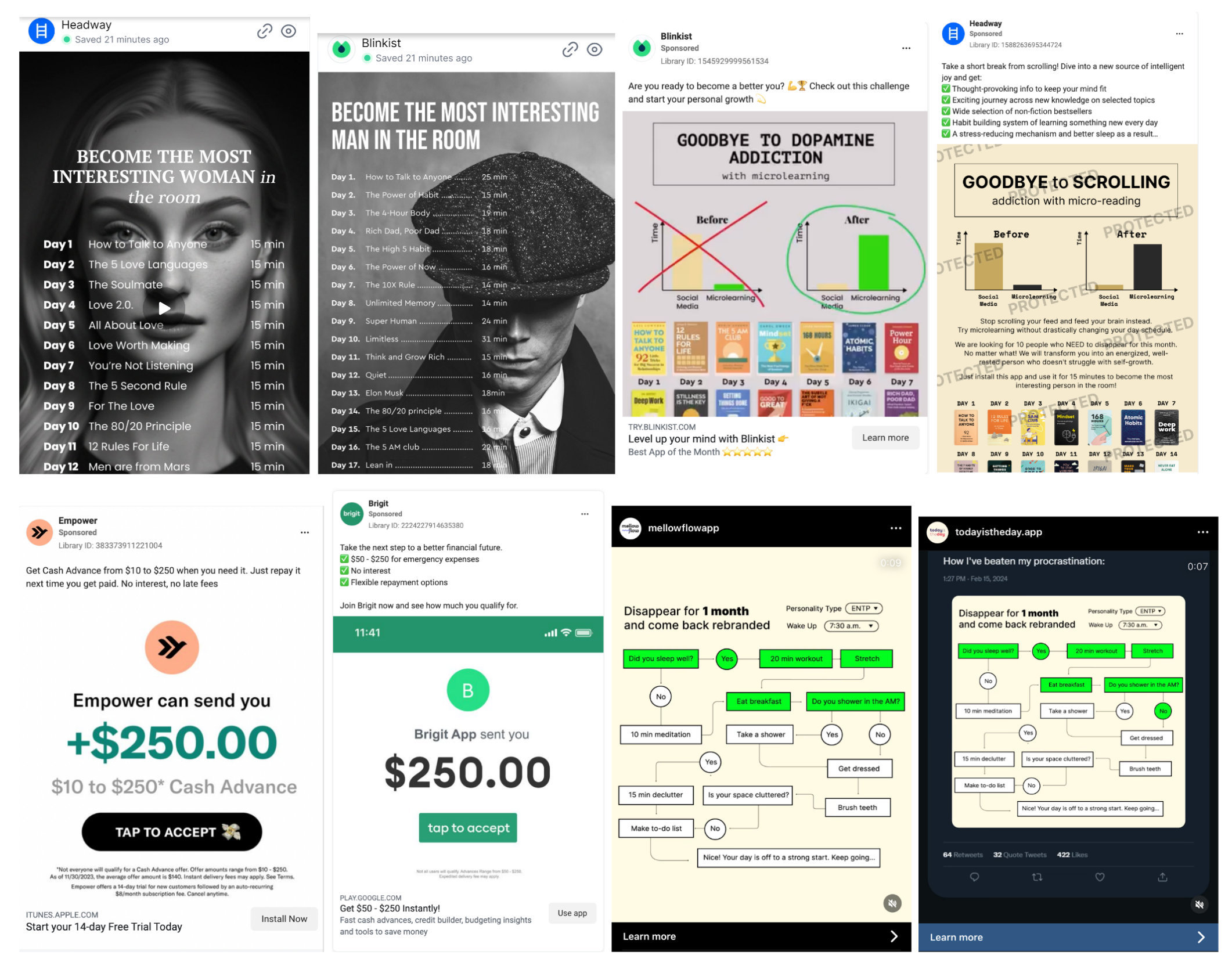
These examples are quite blatant and expose the copying advertiser to significant risk of brand degradation over time if it is unable to independently carve out its own differentiated voice & aesthetic. This is also likely to cause the original advertiser to start copying in return, accelerating the race to the bottom.
In this article we will outline our perspective on how brands can best utilize their creative resources towards the common objectives of 1) maintaining short-term channel stability and iterative wins, and 2) establishing fresh, high-performing creative concepts that elevate performance long-term while maintaining a distinct brand identity. Here we offer three fairly straightforward approaches we employ to ensure our accounts stay ahead of fatigue and our brand partners maintain a unique, leading voice in their markets.
Why are brands copycatting?
First, it’s important to acknowledge that incorporating some degree of copycat strategy is not all bad. Without getting into the ethics of this approach, there are legitimate business reasons that one might consider, or even recommend, some degree of competitor copycatting:
- Defensive positioning – the Meta algorithm is intelligent enough to evaluate an individual asset’s components and serve it to subgroups of your target audience it knows are more likely to engage with that specific asset. By copying ads you smoothen out potential points of differentiation and capture a portion of that creative approach’s net ‘win’.
- Quick wins – every advertiser has at some point been in that state where your creative mix has stagnated for weeks or even months, with all delivery going to a few fatiguing winners and new bets not paying off. Dipping into copycatting in this scenario can unlock new winning pathways and even pull you out of a creative mix rut.
- Accelerating competitors’ fatigue – in the same way an individual asset will experience fatigue, a specific design and messaging approach will burn out, albeit at a slower rate. The entire TikTok ecosystem exemplifies this, where trends can form, saturate, and disappear within a matter of days – think #Cottagecore or #ShantyTok.
There are still degrees of nuance to copycatting that predicate a successful outcome – randomly scanning through your competitor’s Meta Ads Library, picking a few, and then recreating with your own logo wont get you there – but that’s not what we’re here to talk about.
A creative strategy which is overly reliant on following trends and copycatting yields a race to the bottom. This is a safe, defensive approach that aims towards ‘not losing’. Like a snake eating its own tail, copycat-reliant advertisers in emergency mode scramble to chase quick wins and hit targets, while over time erode the perceived foundational differentiations of their brand voice and product. This identity death can leave a growth program in the type of deep rut that causes hard resets & organizational shakeups.

 Like a snake eating its own tail, copycat-reliant advertisers in emergency mode scramble to chase quick wins and hit targets, while over time erode the perceived foundational differentiations of their brand voice and product.
Like a snake eating its own tail, copycat-reliant advertisers in emergency mode scramble to chase quick wins and hit targets, while over time erode the perceived foundational differentiations of their brand voice and product.
A More Sustainable Approach
At Headlight, we’ve settled on a resource allocation strategy that we believe achieves equilibrium between innovation and expansion on proven approaches. In our regular deliverables, we generally try to achieve:
- 25% – following in-vertical trends
- 25% – iterating on current and past winners
- 50% – pursuing concept innovation
Within the ‘innovation’ bucket, there are three primary frameworks that we leverage, listed below, to develop a continuous stream of new ideas. The following section dives into each in detail.
1. Cross-vertical migration
2. Pushing brands into the unexpected
3. Tight Growth + Creative collaboration
1. Cross-Vertical Migration
Frequently we will take a winning ad concept that either we’ve designed or we’ve come across in-market from one vertical and work to migrate it to another. This helps break stagnation and can open up new pathways for ideation. Accomplishing this requires breaking down the ad into its core compositional elements.
We ask & answer a series of questions, including:
- How does the ad represent the problem the product is solving?
- What is the core value proposition presented?
- How is the hook framed, both visually & in messaging?
- How does the message convey emotional benefits?
- What is the production approach?
- How is the script structured?
- How does the ad establish credibility (social proof, accolades, etc)?
- What is the visual sequencing?
- How do visual cues reinforce the message?
- What is the CTA?
Going through this exercise reveals the building blocks which, when added together, have yielded a successful concept. The next step is to play a bit of Mad Libs, replacing the messaging from the example ad with that of our client as precisely as possible. A story to illustrate this…
Mock text message ads first gained prevalence in the FinTech space, where the lack of tangible visual product pushed marketers to find innovative and engaging ways to natively communicate their value proposition. These concepts are casual and conversational, generally taking the angle of a curious friend who is experiencing a problem or asking for assistance.
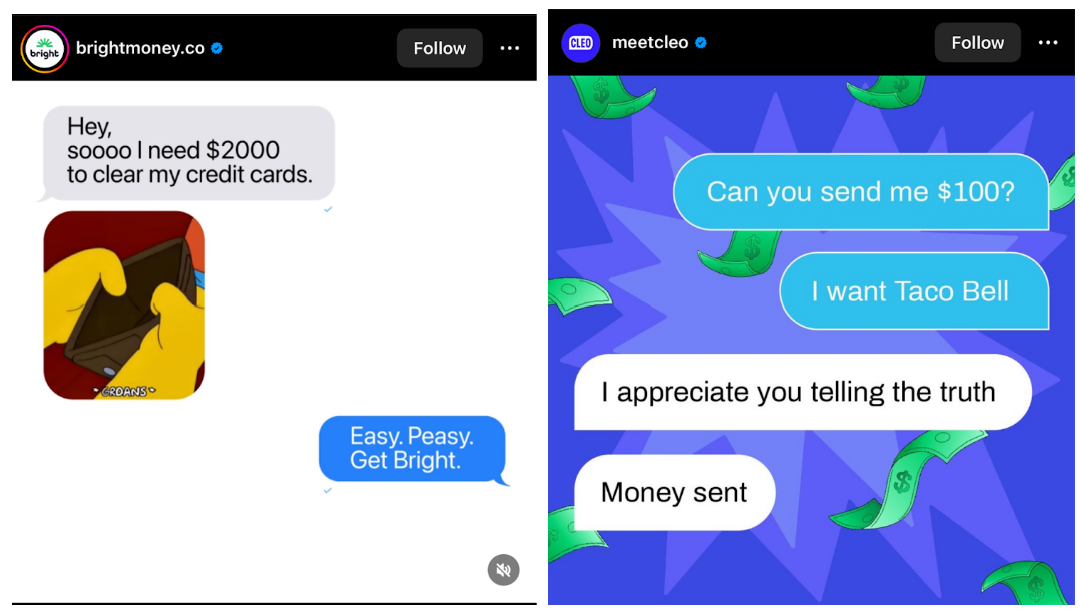
Over time, the success and expansion of this type of creative drove brands from wide varieties of verticals, many of which have physical or digital products. Consumers had begun to normalize consuming marketing messages via mocked cell phone text app UIs to the point where it started to outperform more traditionally artistic or visually appealing presentations.
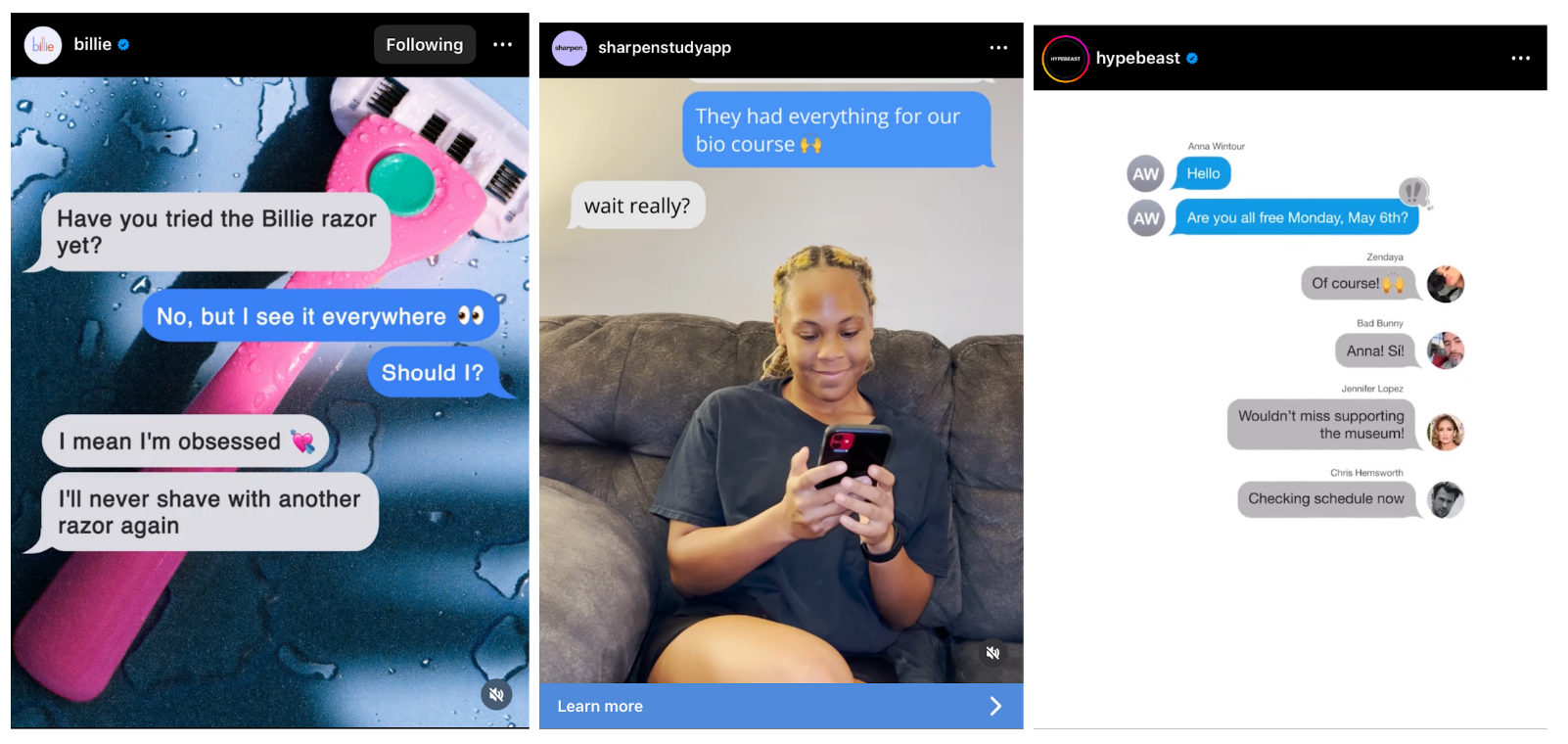
Flash-forward to 2024, and this type of mock conversation has habitualized to such a degree that even the Met Gala, the world’s most prestigious fashion event with tremendous financial resources and opportunities for lavish visual messaging, decided to announce the event via a mock text chain amongst its organizers.
The format has come a long way. The takeaway here is to not limit the scope sources of inspiration to your direct competitive set. Pick a selection of brands that you feel are successfully pushing the envelope on your core channels and monitor the creatives they’re putting in-market. Create a custom collection on Instagram or TikTok to save innovative & inspiring ads to. Make challenging expectations a core principle in the ideation process.
2. Pushing Brands Into the Unexpected
Another very powerful exercise to drive concept innovation is to build out longlists of the universe of possibilities. This should include
- Your team’s technical capabilities;
- All potential messaging approaches: value propositions, framings, feature stories, use cases, emotional benefits, etc.; and
- The wide spectrum of visual styles, whether or not they initially seem relevant to the product
We’ve taken a sample pass of #s 2 and 3 below:
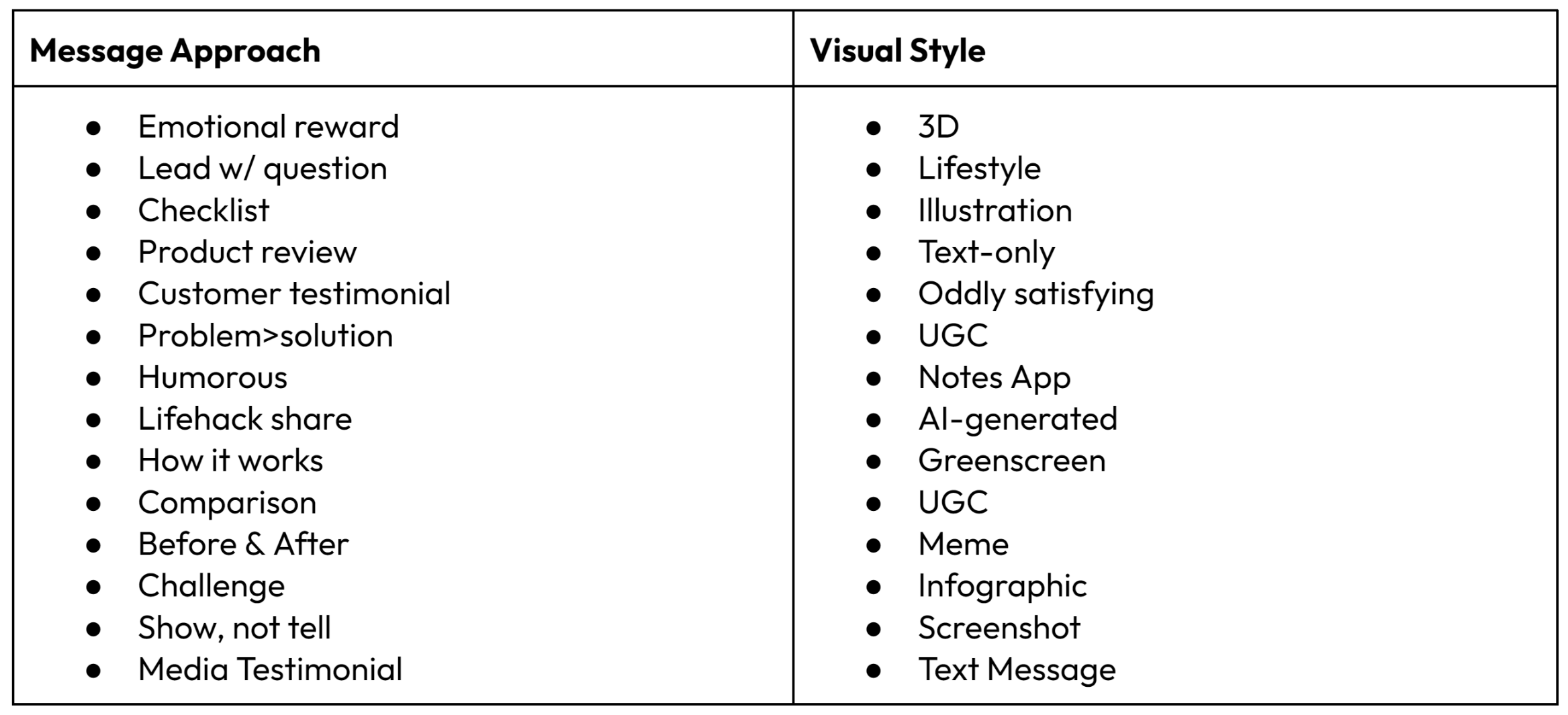
After brainstorming out just about every example you can think of, go through the exercise of taking the last ten or so ‘winners’ for a given channel. Break them down according to these parameters. What permutations have worked? Are there commonalities? Play around with swapping-in different elements to drive ideation.
Step 1: Lay out all possible messaging vs visual angles

Step 2: Think about all possible combinations if you mixed several of them
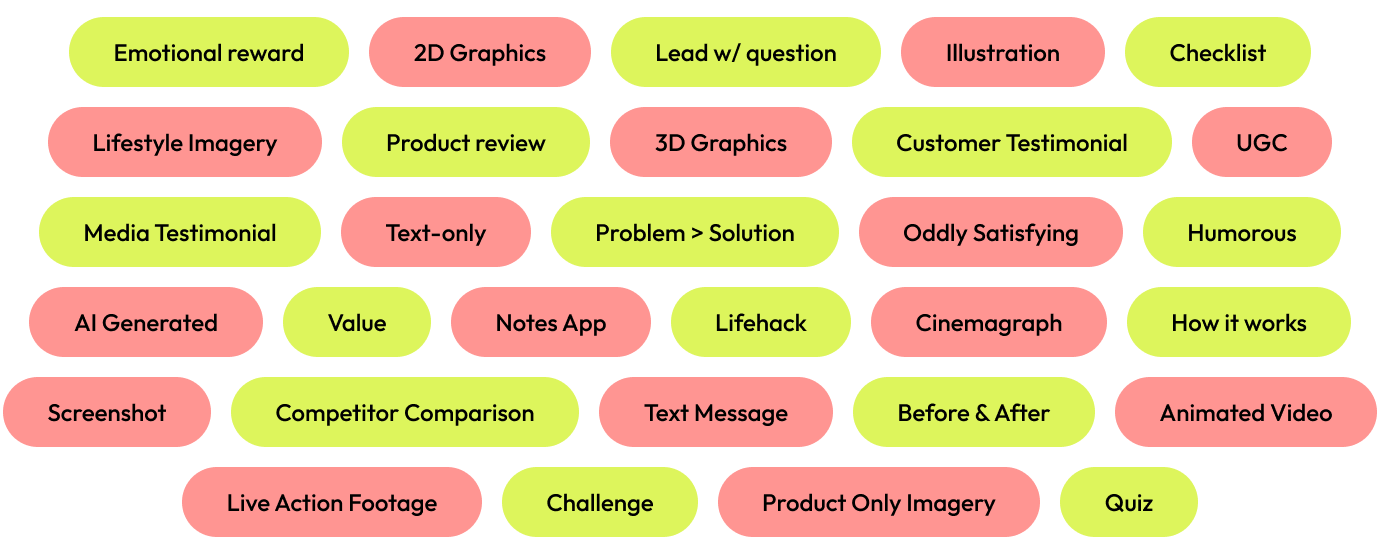
Step 3: Build initial Ad concepts with potential combinations & test them out

Step 4: Permutate multiple different messaging + visual blocks on top of existing ones, based on results

Step 5: The possibilities are endless! Challenge yourself to make combinations that defy the norms to differentiate yourself & to find new successful concepts.
Maybe there was a ‘How It Works’ cinemagraph carousel that performed well and fatigued. What would the same concept look like in a Native ‘Notes’ format? Alternatively, what if ‘How It Works’ was swapped for a hit-list cinemagraph carousel of top proven-out consumer hooks? Or, maybe add a meta-layer to the carousel by encasing the content within a UGC greenscreen and explainer voice over.

 Without introducing any genuinely novel creative ideas, thoroughly going through this exercise can generate months’ worth of new concepts to reinvigorate your ad mix and open up new pathways for sustaining performance.
Without introducing any genuinely novel creative ideas, thoroughly going through this exercise can generate months’ worth of new concepts to reinvigorate your ad mix and open up new pathways for sustaining performance.
We’ve found that while many organizations include a layer of script modularity in their creative planning, very few add the orthogonal layer of mixing and matching messaging approaches and visual styles. Without introducing any genuinely novel creative ideas, thoroughly going through this exercise can generate months’ worth of new concepts to reinvigorate your ad mix and open up new pathways for sustaining performance.
3. Tight Growth & Creative Collaboration
One thing that consistently surprises us at Headlight is how often we hear about marketing agencies or even in-house teams where media buyers and creatives are almost entirely siloed from one another. From our perspective, the integration of tactical workflows between these teams is one of the most high-leverage surface areas an organization can get right in pursuit of a best-in-class growth program. Throwing a concept brief with a bit of color-coded CTR & CPA data (often not even that!) over a wall to an Art Director and then patiently waiting for ‘vFinal’ assets to be returned & launched leaves a giant void at the center of one of the core workflows in Marketing.

 From our perspective, the integration of tactical workflows between these teams is one of the most high-leverage surface areas an organization can get right in pursuit of a best-in-class growth program.
From our perspective, the integration of tactical workflows between these teams is one of the most high-leverage surface areas an organization can get right in pursuit of a best-in-class growth program.
We’ve developed a rigorous approach for testing creative, which we’ve discussed at-length in prior articles. Our Creative & Growth orgs collaboratively discuss the outcomes of these tests at a regular cadence, aligning on key learnings and subsequent hypotheses. Being consistent and thorough on this feedback loop generates steady momentum as well as mutual understanding of where the brand is at, what words and visual hooks are working, and the top opportunities for expansion.
Maintaining this constant engagement makes more team members feel comfortable bringing up their ideas and sharing analyses of what’s causing the results we’re seeing. It brings the Creative team closer to what’s happening on the channels and the Media team closer to the creative process. Over the years, a large portion of our top performing concepts are a direct result of this deep intertwining of workflows.
To learn more about what that looks & see what it could do for your business, reach out below.
Headlight’s team of experts are offering a free strategic Audit Session across Growth, Creative & Analytics – a unique opportunity for brands to learn more about how to scale spend with incrementality in mind.




